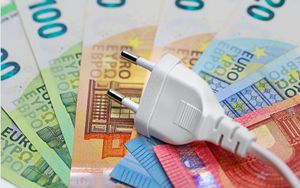(Finance) – In Italy we spend 77 euros a year to cook with an electric oven, i.e. 42% more than the Swedes, 63% more than the French and even more than double (+107%) than the Spaniards. The difference? No, it’s not the recipes, but the electricity rates. Facile.it examined the latest Eurostat data relating to the average electricity price applied to domestic customers in Europe, discovering that, in the first half of the year, Italy was one of the countries with the highest tariffs.
In particular, among the 27 EU countries, Italy was the sixth most expensive country in terms of the cost of electricity, with an average tariff, including taxes and charges, equal to €0.378/kWh. There are few EU states with a higher value; among these there are, for example, the Netherlands (+26%), Belgium (+15%) and Germany (+9%). The list of countries with a lower price than ours is longer: limiting ourselves to the main ones, we find Sweden (-29%), Ireland (-35%), France and Greece (both -39%), Spain (- 52%), not to mention Hungary, where the average tariff for domestic customers was even lower by 69%.
In detail, to do the washing machine (220 washes a year) in Italy we spend around 111 euros on electricity, while the French have to budget just 68 euros, which drops to 53 euros in Spain. Little consolation: for Germans and Belgians the cost exceeds 120 euros. Regarding the use of the refrigeratorcontinues Facile.it, considering that we use it almost continuously all year round, the difference between the different states of Europe is felt even more: for example, to power a class B appliance you need around 193 euros a year in Italy, while the Irish spend 126 euros, which becomes 105 euros for those living in Portugal and, even, just 93 euros for those residing in Spain.
Also for washing dishes with the dishwasher we spend considerably more in Italy; using the appliance every other day we spend 92 euros a year. If it is true that in the Netherlands it even reaches 116 euros, things are decidedly better, among others, in Greece and France (both 57 euros), in Spain (45 euros) and in Hungary (28 euros). Even common gestures such as watching television or drying your hair take on a different economic dimension from one country to another: for 4 hours of television programs a day, every day, for example, the 49 euros spent by Italians become 32 in Ireland, while a hairdryer in action for 5 minutes a day costs, per year, 23 euros in Italy, 14 euros in France and 7 in Hungary.
Taking the consumption of a typical Italian family as a reference (2,700 kWh) and taking into consideration the tariffs for the first half of 2023, we discover that, potentially, electricity bills in Italy this year could weigh around 1,021 euros. In European countries where energy is more expensive, for the same consumption, it would hopefully reach, for example, 1,114 euros in Germany and 1,283 euros in the Netherlands.
Other European citizens are luckier; in Sweden, for example, the electricity bill would be 720 euros, 669 euros in Ireland and 628 euros in Greece. Same family, same consumption, but if he lives in France he would pay 626 euros, in Portugal 559 euros, not to mention Spain with its 492 euros.
Although it is only about 750 km away from Italy as the crow flies, Hungary – at least from the point of view of electricity prices – seems to be light years away: just think that, with the same consumption, with the tariffs in force in the first half of the year, the annual expenditure incurred by Hungarian families would be equal to just 313 euros.
